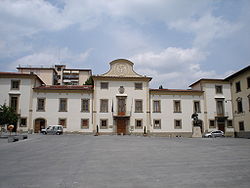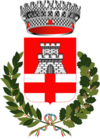Pontassieve
| Pontassieve | ||
|---|---|---|
| Comune | ||
| Comune di Pontassieve | ||
 |
||
|
||
| Location of Pontassieve in Italy | ||
| Coordinates: 43°46′N 11°25′E / 43.767°N 11.417°E | ||
| Country | Italy | |
| Region | Tuscany | |
| Province / Metropolitan city | Florence (FI) | |
| Frazioni | Acone, Colognole, Doccia, Le Falle, Le Sieci, Fornello, Lubaco, Madonna del Sasso, Molino del Piano, Montebonello, Monteloro, Monterifrassine, San Martino a Quona, Santa Brigida | |
| Government | ||
| • Mayor | Monica Marini (since May 2014) (Partito Democratico, Lista Civica Marini Sindaco) | |
| Area | ||
| • Total | 114.4 km2 (44.2 sq mi) | |
| Elevation | 108 m (354 ft) | |
| Population (1 January 2007) | ||
| • Total | 20,622 | |
| • Density | 180/km2 (470/sq mi) | |
| Demonym(s) | Pontassievesi | |
| Time zone | CET (UTC+1) | |
| • Summer (DST) | CEST (UTC+2) | |
| Postal code | 50065 Pontassieve, 50060 Cusio, 50060 Molino del Piano, 50060 Santa Brigida, 50069 Sieci (Le Sieci), 50065 Pontassieve (other frazioni) | |
| Dialing code | 055 | |
| Website | Official website | |
Pontassieve is a comune (municipality) in the Province of Florence in the Italian region Tuscany, located about 14 kilometres (9 mi) east of Florence, nearby Fiesole, at the confluence of the Arno and Sieve rivers.
The first rulers of the area were the Quona nobles, whose Lordship is documented from the 11th century. These, a branch of whom at a later date also appeared under the name of Filicaia, settled in Florence at the end of the 12th century and in 1207 sold a large part of its territory of jurisdiction to the Bishopric of Florence.
In 1375 Florence had a castle erected here for an essentially strategic use on the land of Pontassieve. First the town took the name of "Castel Sant’Angelo" (Saint Angel Castle), later obtaining the current referring to the importance of the bridge on the river, that was the main way joining the Republic of Florence to the territories of the Mugello, Casentino and the city of Arezzo.
At the end of the 18th century the new House of Lorraine’s Dukes gave a great impulse to the town economy. Thanks to the Ducal works for the reclamation of the territory and the opening of two new roads, that joined Pontassieve to the Casentino and Emilia, Pontassieve lived a remarkable economic growth. Under the Lorenese domination Pontassieve was elevated to the rank of Vicarship’s Town Hall comprising part of the territories belonging to the Arno and Sieve valleys.
In 1859 the construction of a Florence-Rome railway (later followed by the Florence-Borgo San Lorenzo line) gave an additional impulse to the town's economy, turning it into an industrial hub. In 1861 Pontassieve was annexed to the newly formed Kingdom of Italy.
During World War II Pontassieve, for its importance as a rail junction, suffered substantial damage: the railways and the town itself were repeatedly bombed by Allied planes, which destroyed it almost entirely. The town's present day aspect is due, for the most part, to the post war reconstruction. Even though, the town has kept its original medieval look in the city center.
...
Wikipedia


